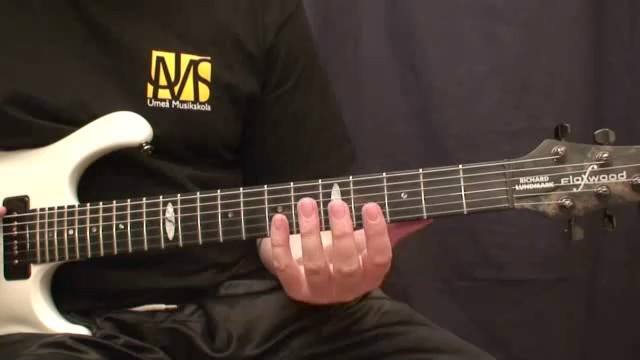The next form of the 9th form we’ll be looking at is the Minor 9th form which is built by taking a Minor 7th chord form (C-Eb-G-Bb), and adding on the 9th to it to give us a Minor 9th chord, which goes like: (C-Eb-G-Bb-D) Intervalically, this can be seen as: (Root, Minor 3rd, Perfect 5th, Minor 7th, Major 9th).
(Ex.19-20) The A form of this is built by taking the original Dominant 9th chord we had before and lowering the 3rd on the D string one fret to Eb. The E form is built by taking the original Dominant 9th form we had before and lowering the 3rd on the G string down a fret to Eb.

We will now be creating a Major 9th chord. We create this by taking a Major 7th chord form and adding on the 9th to it to create a Major 9th chord. the chord formula goes: (C-E-G-B-D). Intervalically, this can be thought up as: (Root, Major 3rd, Perfect 5th, Major 7th, Major 9th.)
(Ex.21-22) To create the A form of this chord, we take the original Dominant 9th form we had at the start and raise the Db (b7th) on the G string up one fret to G. For the E form of this, we build this one with the root on the E string, the 3rd on the A string, the 7th on the D string, the 9th on the G string and the 5th on the B string.

The next chord that we will be going over is the Major Add9 chord. Now, we build this chord by taking a Major Triad (C-E-G) and adding on the 9th (D) on top of the 5th, which will now alter the formula to: (C-E-G-D). Intervalically, this chord can be thought up of as: (Root, Major 3rd, Perfect 5th and Major 9th.)
(Ex.23-24) To create the A form of this chord, we have the root on the A string, the 5th on the D string, the 9th on the G string, the 3rd on the B string and the 5th again on the high E string. For the E form, we have the root on the low E string, the 5th on the A string, the 9th on the D string, the 3rd on the G string, the 5th again on the B string and (if you want) the root again on the high E string.

To create a Minor Add9 chord, we take a Minor Triad (C-Eb-G) and add the 9th to it, to get the formula: (C-Eb-G-D) Intervalically, this can be seen as (Root-Minor 3rd-Perfect 5th- Major 9th).
(Ex.25-26) For the A and E forms of this chord, all we do is take the Major Add9 forms we just learned and lower the 3rd one fret down to Eb. (The E form of this is kinda tricky to play because of the stretch between the 9th and the minor 3rd.)

This concludes part 4 of this tutorial. I have included as many open major and minor add9 chords as I could, because these are the ones you are primarily going to use in your playing, especially if you are a rock-type of player like I am. 

















